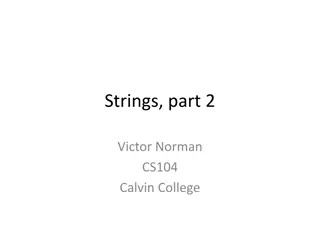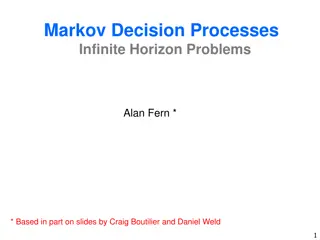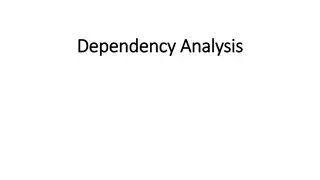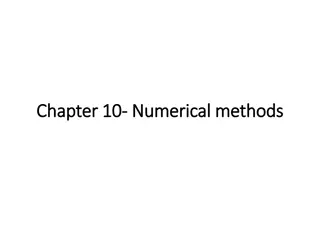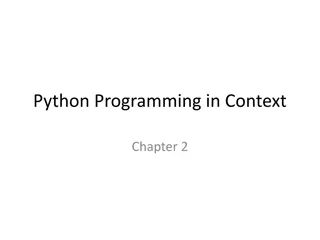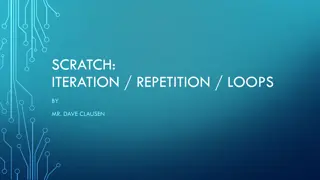
Manipulating Series in Control Structures
Explore control structures such as iteration, looping, and problem-solving techniques to manipulate series in computer programming. Learn to calculate totals, averages, find maximum and minimum values, and more using nested loops and pseudocode. Dive into sequential, selection, and iterative processes to enhance your programming skills.
Download Presentation

Please find below an Image/Link to download the presentation.
The content on the website is provided AS IS for your information and personal use only. It may not be sold, licensed, or shared on other websites without obtaining consent from the author. If you encounter any issues during the download, it is possible that the publisher has removed the file from their server.
You are allowed to download the files provided on this website for personal or commercial use, subject to the condition that they are used lawfully. All files are the property of their respective owners.
The content on the website is provided AS IS for your information and personal use only. It may not be sold, licensed, or shared on other websites without obtaining consent from the author.
E N D
Presentation Transcript
Control Structure Siti Nurbaya Ismail Senior Lecturer Faculty of Computer & Mathematical Sciences Universiti Teknologi MARA Kedah (e): sitinurbaya@kedah.uitm.edu.my (b): https://sitinur151.wordpress.com 1
Control Structure Previously Previously Sequential Creating a set of instructions to complete a task. Selection A decision within a computer program when the program decides to move on based on the results of an event. Iteration / Looping Loop Control Structure Basic Algorithm Using Looping a) Calculate the total or sum b) Calculate the average c) Find maximum value and minimum value d) Count Single Looping Nested Looping Pseudo code & Flowchart Determine Output / Tracing Table
Control Structure Today Manipulate a series Sentinel Loop Infinite Loop Nested Loop Quick Revision Draw Diagram Using Nested Loop
Iteration Iteration Control Structure Control Structure Manipulate a series
Problem Solving: Manipulate a series Calculate the total of the following series: 3 + 6 + 9 + 12 + 15 + until 30 times {consistent sequence} = Input Process The first number is 3 The different between a number and second number is 3 The relation between next number and current number is next number = current number + 3 OR number = number + 3 Problem Definition: Output Nothing as the value for each number is identified Total of 30 numbers
Problem Solving: Manipulate a series Calculate the total of the following series: 3 + 6 + 9 + 12 + 15 + until 30 times {consistent sequence} Start total = 0 number = 3 counter = 1 While ( counter <= 30 ) total = total + number number = number + 3 counter = counter + 1 endWhile Display total End
Problem Solving: Manipulate a series Calculate the total of the following series: 3 + 6 + 9 + 12 + 15 + until 30 times {consistent sequence} Start total = 0 number = 3 counter = 1 While ( counter <= 30 ) total = total + number number = number + 3 counter = counter + 1 endWhile Display total End
Problem Solving: Manipulate a series Calculate the total of the following series: Y= 2/5 + 4/10 + 6/15 + until 15 times {consistent sequence} Start Y= 0 x = 2 z = 5 counter = 1 While ( counter <= 15 ) Y = Y + (x/z) x= x + 2 z = z + 5 counter++ endWhile Display Y
Problem Solving: Manipulate a series Calculate the total of the following series: 1 + 6 + 9 + 12 + 15 + until 30 times {a pattern of sequence} Problem Definition: Input Process The first number is 1 The second number is 6 The different between first number and second number is 5 Starting from the 2nd number onwards, the different between the number and second number is consistent, icrease by 3 next number = current number + 3 OR number = number + 3 Output Nothing as the value for each number is identified Total of 30 numbers
Problem Solving: Manipulate a series Calculate the total of the following series: 1 + 4 + 9 + 16 + 25 + 36 until 10 times {a pattern of sequence} Start total = 1 number = 4 counter = 2 add=5 While ( counter <= 10 ) total = total + number number = number + add counter = counter + 1 add=add+2 endWhile Display total End 1+3=4 4+5=9 9+7=16 16+9=25 25+11=36
Problem Solving: Manipulate a series Calculate the total of the following series: 1 - 3 + 5 - 7 + 9 - until 30 times {a pattern of sequence} Start total = 1 number = 3 X counter = 2 While ( counter <= 30 ) IF(counter%2==0) total = total number ELSEIF(counter%2==1) total = total + number ENDIF number = number + 2 counter = counter + 1 endWhile 1||0.5||0.25
Problem Solving: Manipulate a series You are given the following series. Calculate H where H = F + G F = 1 + 7 + 13 + 19 + 25 + 31 + 37 + until 10 times G = 4 + 8 + 12 + 16 + 20 + until 15 times H = F + G {a missing formula} Problem Definition: Input Process Output Nothing as the value for each number is identified Calculate Total F Calculate Total G Calculate Total H : number = number + 6 : number = number + 4 : Total F + Total G : 10 times : 15 times Total of F + G
Problem Solving: Manipulate a series Start F = 0 number = 1 counter = 1 While ( counter <= 10 ) F = F + number number = number + 6 counter = counter + 1 endWhile G = 0 number = 1 counter = 1 While ( counter <= 15 ) G = G + number number = number + 4 counter = counter + 1 endWhile H = F + G Display H End
Problem Solving: Manipulate a series Calculate the factorial of a positive number. Factorial for n! as follows: Factorial = 1 x2 x 3 x x n 1 x n {given a formula} Problem Definition: Input Process n will be input by user, n is the end value factorial = factorial * number Output n factorial
Problem Solving: Manipulate a series Start factorial = 1 Read n number = 1 While ( number <= n ) factorial = factorial * number number = number + 1 endWhile Display factorial End
Problem Solving: Manipulate a series Flow Chart ?
Start total = 1 number = 4 counter = 2 add = 3 While ( counter <= 10 ) total = total + number add =add+2 number = number + add counter = counter + 1 endWhile Display total End 4->9 =5 + 2 9->16 = 7 + 2 16 -> 25 = 9 + 2 25
tart i=2 num=2 numb=5 total=0 While(i<=15) total=(num/numb)+total num=num+2 numb=numb+5 i++ EndWhile Display total End
Start End total=1 number=1 count=1 while(count<20) number=number+count total=total+number count++ Endwhile display total
start read num1,num2,num3 multable=num1 firstnum=num2 stop=num3 counter=2 Total=0 While (counter<stop) multable=multable+1 Total=firstnum*multable counter=counter+1 Display firstnum, x , multable, = , Total Display newline end Endwhile
Iteration Iteration Control Structure Control Structure Sentinel Loop
Iteration: Sentinel Loop scenario where the exact number of repetition is unknown but there must be a condition to stop the repetition the syntax is: Start initial value of a loop while ( condition ) statement(s) to be repeated statement to update the condition endWhile End all statements in between while .. endWhile will be executed when the condition is TRUE the repetition is stop when the condition is FALSE.
Iteration: Sentinel Loop Ask the user to enter a group of numbers. The last number is 999. Display all entered numbers. Start Read number while ( number is =! 999 ) Display number Read number endWhile End Input mark of students. Display mark which is less than 50. Stop the process when the user enters invalid mark. Start Read mark while ( mark => 0.0 AND mark <= 100 ) If ( mark < 50 ) Display mark EndIF Read mark endWhile End
Tracing Algorithm: Sentinel Loop Given the following algorithm; Start sentinel = -1 count = 0 totalSquare = 0 Read x while (x =! sentinel) totalSquare = totalSquare + x2 count = count + 1 Read x endWhile Display total = , totalSquare Display nextline Display count = , count End QUESTION What is the value of the sentinel value used? sentinel = -1 What is the body of repeat statements? total-square = total-square + x2 count = count + 1 Read x What is the value of total-square when the user enters the following data ? -1 3 9 total = 115 count = 3 5
Tracing Algorithm: Sentinel Loop Start i = 1 QUESTION Given the following algorithm; XX = 0 Display enter an integer : Read number Display MYSTERY MESSAGE , newline while ( i <= number ) If ( number % i == 0) XX = XX + 1 ; Display i , EndIF i = i + 1 endWhile diplay newline Display There are , XX , MYSTERY MESSAGE FOR , number End Trace the pseudo code for the following data: i- 9 output? ii- 8 output? Give a meaningful name for XX. Replace MYSTERY MESSAGE FOR with a suitable words.
Problem Solving: Sentinel Loop Find the best mark for the first test in a class. Assume that the number of student is unknown. The process stops when the user enters an invalid mark. Problem Defination In this problem, the user has to enter the student s test mark many times. The process stops when the user enters invalid mark. Normally the valid mark is in the range of 0.0 to 100.0.
Problem Solving: Sentinel Loop Start Display Enter test mark for the first student Read testMark max = 0 while ( testMark => 0.0 AND testMark <= 100.0 ) If (testMark > max ) max = testMark EndIF Display Enter test mark for next student Read testMark endWhile Display The highest mark , max End
Problem Solving: Sentinel Loop Ask the user to enter a set of numbers. Calculate how many number is divisible by 5. The process stops when the user enters 999. (pg 292) Calculate the mark and the grade for students. The mark is the average of two highest test mark between three test marks. The process stops when there are no more data to process. Use the following table to determine the grade. (pg 300) Mark 100 80 79 65 64 60 59 40 39 0 Grade A B C D E Calculate the total of the following series and count how many numbers involved. (pg 296) 3 + 6 + 9 + 12 + + 312 + 315 Count how many numbers which is divisible by 7 in between 1 and 100. (pg 297) Display the following menu. choice + * - x Ask the user to enter a choice. Repeat until the user enters x as a choice. (pg 303) Operation add 2 numbers multiply 3 numbers difference of 2 numbers exit Calculate the mark and the grade for students. The mark is the average of two highest test mark between three test marks. The process stops when there are no more data to process. Use the following table to determine the grade. (pg 300)
Iteration Iteration Control Structure Control Structure Infinite Loop
Iteration: Infinite Loop non stop loop the repetition keeps running, it is never stop the syntax is: Start count = 0 number = 7 while (number <= 100) count = count + 1 endWhile Display count End The above algorithm is missing the statement to increase the value of the variable number. It makes the condition (number 100) always true because the value of the variable number remains with 7. It makes the algorithm runs forever.
Iteration Iteration Control Structure Control Structure Nested Loop
Iteration: Nested Loop inside a loop there is another loop ; inner loop and outer loop The execution of this type of structure is, the computer will finish the inner loop for every iteration of outer loop Start count number while (number 100) count endWhile Display count 0 7 count + 1 End
Iteration Iteration Control Structure Control Structure Draw a Diagram Using Nested Loop
Iteration: Draw a Diagram Using Nested Loop Display the following diagram: &&&&&& &&&&&& &&&&&& &&&&&& 1 2 3 4 5 6 Start 1 row = 1 while (row < = 4) 2 row = 4 3 col = 1 while (col <= 6) EndWhile Display newline 4 Display & col = col +1 col = 6 row = row + 1 endWhile End
Iteration: Draw a Diagram Using Nested Loop Display the following diagram: $$$$$ $$$$$ $$$$$ ##### ##### 1 2 3 4 5 Start line = 1 While (line <= 5 ) If (line <= 3) countSymbol = 1 While (countSymbol <= 5) Display $ countSymbol++ EndWhile 1 2 Display newline line = 5 3 Else line <= 3 4 countSymbol = 1 While (countSymbol <= 5) Display # countSymbol++ EndWhile 5 else cauntSymbol = 5 Display newline EndIF line++ EndWhile End
Start Iteration: Draw a Diagram Using Nested Loop Display the following diagram: $$$$$$ $ $ $ $ $ $ $ $ $ $ $$$$$$ 1 2 3 4 5 6 row = 1 while (row < = 7) If ( (row = =1) OR (row = =7) ) column = 1 while (column <= 6) Display $ column++ endWhile 1 2 3 4 5 6 7 Else column = 1 while (column <= 6) If ( (column = =1) OR (column = = 6) ) Display $ Else Display EndIF column++ endWhile row = 7 EndIF Display newline row ++ EndWhile column = 6 End
Iteration: Draw a Diagram Using Nested Loop Flow Chart ?
Iteration: Draw a Diagram Using Nested Loop Display the following diagram. @ @@ @@@ @@@@ @@@@@ 5 1 2 3 4 row = 5 1 2 3 4 5 column = 6 Analysis: We can assume that the diagram is a square, consisting of five rows and five columns. The diagram consists of @ symbols and white space. We can solve the problem using a matrix concept.
Iteration: Draw a Diagram Using Nested Loop In mathematics and computer science, a matrix is a set of numbers laid out in tabular form (in rows and columns). The matrix 5 x 5 means that the matrix consists of five rows and five columns. Each element of the matrix has the value of row and column as follows: @ @@ @@@ @@@@ @@@@@
Iteration: Draw a Diagram Using Nested Loop When we compare the value of rows and columns to determine where the @ symbol is located and where is the location of the white space, we found that @ symbols are at the element where the value of row is greater or equal to column ( row column).
Iteration: Draw a Diagram Using Nested Loop Start row = 1 while (row < = 5) Display the following diagram. @ @@ @@@ @@@@ @@@@@ 1 2 3 4 5 1 column = 1 while (column <= 5) 2 3 4 row = 5 If (row => column) Display @ Else Display EndIF 5 column = 5 column++ EndWhile row ++ endWhile End
Iteration: Draw a Diagram Using Nested Loop Flow Chart ?
Iteration: Draw a Diagram Using Nested Loop Symbols $ are at the following positions : (1,1) (1,2) (1,3) (1,4) (1,5) (1,6) (2,1) (3,1) (4,1) (5,1) (6,1) (7,1) (7,2) (7,3) (7,4) (7,5) (7,6) $ $ $ $ $ $ $ $ $ $ $ $ $ $ $ $ $ $ $ $ $ $ (2,6) (3,6) (4,6) (5,6) (6,6) OUTPUT Analysis: - $ symbols are at the positions: - all columns in the first row - all columns in the seventh row - all rows at the first column - all rows at the sixth column : ( when row == 1 ) : ( when row == 7 ) : ( when column == 1 ) : ( when column == 6 )
Start row = 1 while (row < = 7) If ( (row = =1) OR (row = =7) ) Iteration: Draw a Diagram Using Nested Loop column = 1 while (column <= 6) Display ( row , column ) column++ endWhile Display the following diagram. $ $ $ $ $ $ $ $ $ $ $ $ $ $ $ $ $ $ $ $ $ $ ? Else column = 1 while (column <= 6) If ( (column = =1) OR (column = = 6) ) Display ( row , column ) Else Display EndIF column++ endWhile (1,1) (1,2) (1,3) (1,4) (1,5) (1,6) (2,1) (3,1) (4,1) (5,1) (6,1) (7,1) (7,2) (7,3) (7,4) (7,5) (7,6) (2,6) (3,6) (4,6) (5,6) (6,6) EndIF Display newline row ++ EndWhile End





